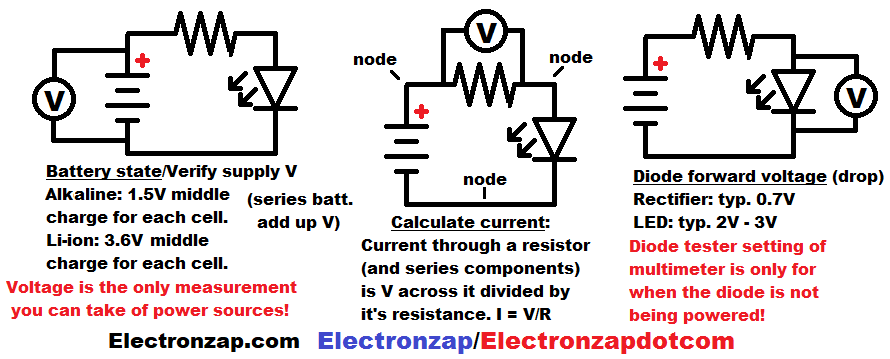Table of Contents
Multimeters are mostly used to measure voltages. Luckily, measuring voltage is a pretty straight forward thing to do, and is very safe, if done properly.

- Set the meter to measure voltage and turn it on if it doesn’t turn on automatically.
- Auto ranging meters will probably only have 1 voltage position (V) for it’s dial.
- Non auto ranging meters will show a range of voltages. Set the dial to a voltage that is higher than you will be measuring.
- Make sure it is set to measure DC if you are measuring a DC voltage. If measuring an AC voltage, then make sure it is set to AC.
- DC stands for direct current. That means that the voltage is set in one direction only. Therefore any resulting current will also flow in just one direction.
- AC stands for alternating current. That means the voltage repeatedly changes direction. Any resulting current will flow in one direction for a bit, and then flow in the other direction for a bit. Continuing to alternate for as long as power is applied, as long as current is allowed to flow in both directions.
- Make sure the probes are plugged into the correct slot of the multimeter for measuring voltages.
- Connect the metal part of the probes to the 2 terminals/nodes that you want to measure. Always hold on to the plastic part of the probes, especially with higher voltages. Never measure something that exceeds the voltage rating of the probes and meter.
- Metal part of the red probe touches the more positive side of the voltage being measured.
- Black probe metal part touches the more negative side of the voltage being measured.
- Reversing which terminals/nodes that the probes are touching is OK as long as it is a digital multimeter. It will just show up as a negative voltage. Analog meters (a moving needle) might be damaged by a reversed voltage.
- Read the results on the display.
- Be careful that the probes don’t short circuit any part of the circuit. A short is when there is a conductive path from one part of the circuit to another, where there shouldn’t be one. Usually it is metal on metal contact.
- If one probe touches 2 different parts (nodes) of the same circuit at the same time, such as both terminals of a battery being measured, then that is a short circuit.
- Both probes touching different parts of the circuit, but while coming into contact with each other, will also result in a short circuit.
- Turn off the meter when you are done.
To support this site, check out the following links:
Low priced multimeter that I do not have. But it is low priced, sells a lot and has many positive reviews. An affiliate link ad.
- Become a Patron!
- Check out my YouTube videos! https://www.youtube.com/c/Electronzap/videos
- Products I used in my videos or otherwise think look like a good buy. As an Amazon associate, I earn from qualifying purchases. https://www.amazon.com/shop/electronzapdotcom
- Information on this site is not guaranteed to be accurate. Always consult the manufacturer info/datasheet of parts you use. Research the proper safety precautions for everything you do.
- Electronzap is a participant in the Amazon Services LLC Associates Program, an affiliate advertising program designed to provide a means for sites to earn advertising fees by advertising and linking to amazon.com.